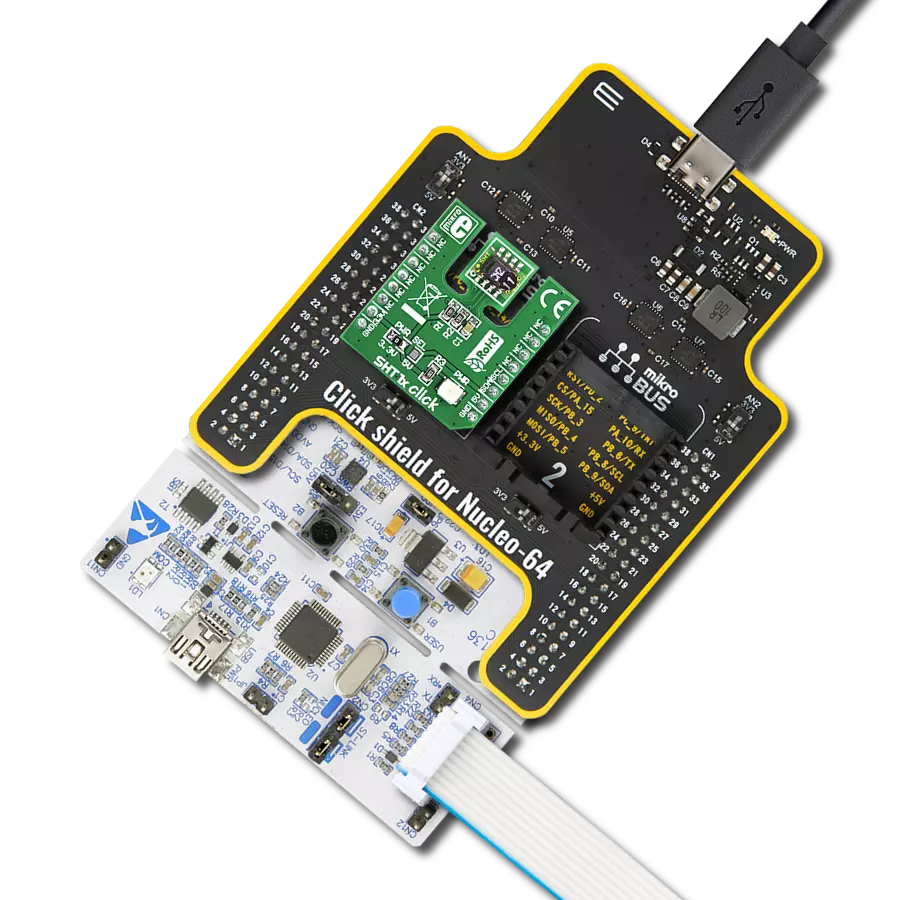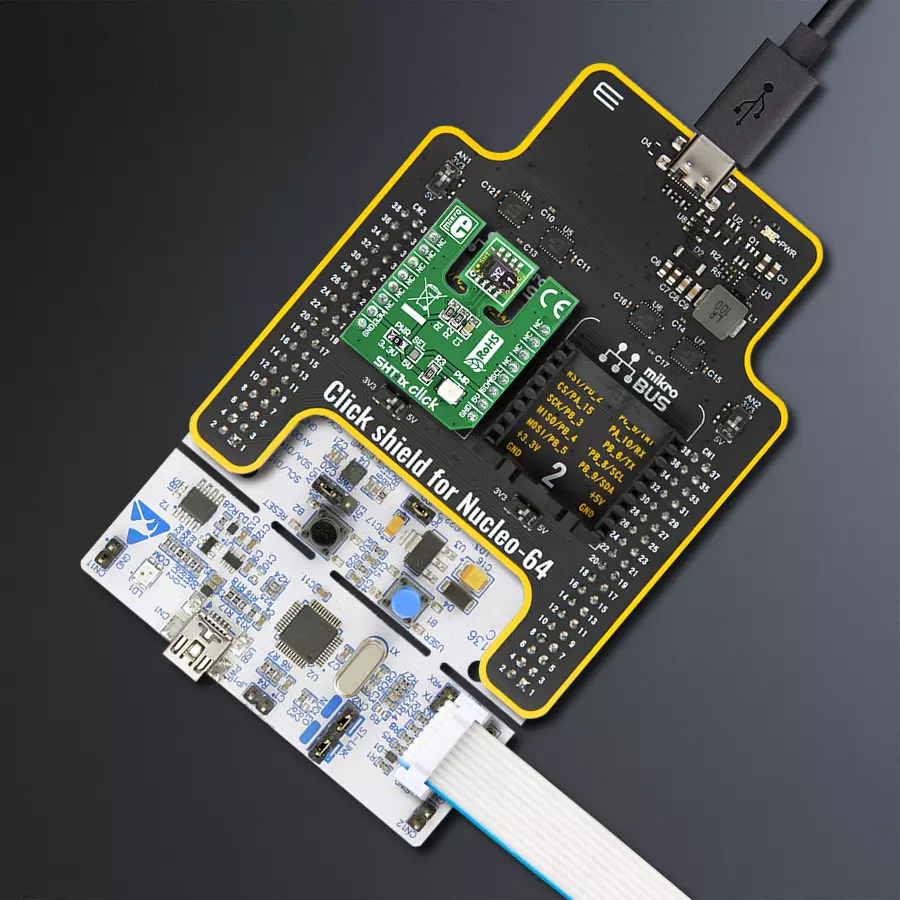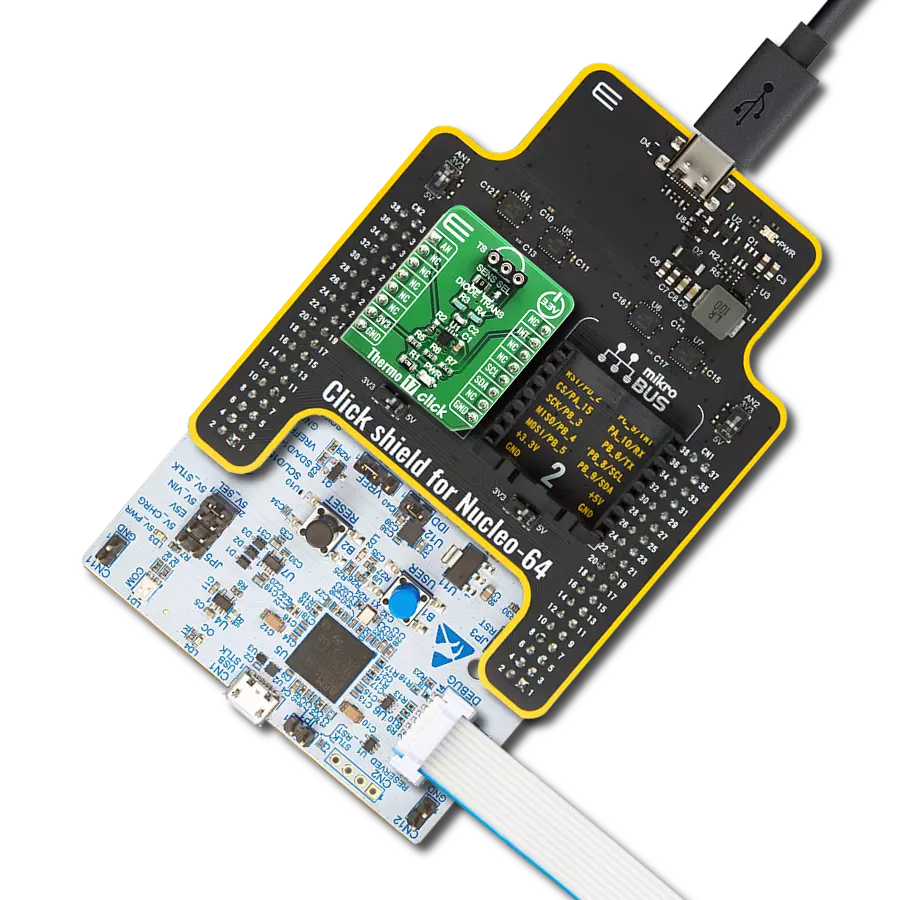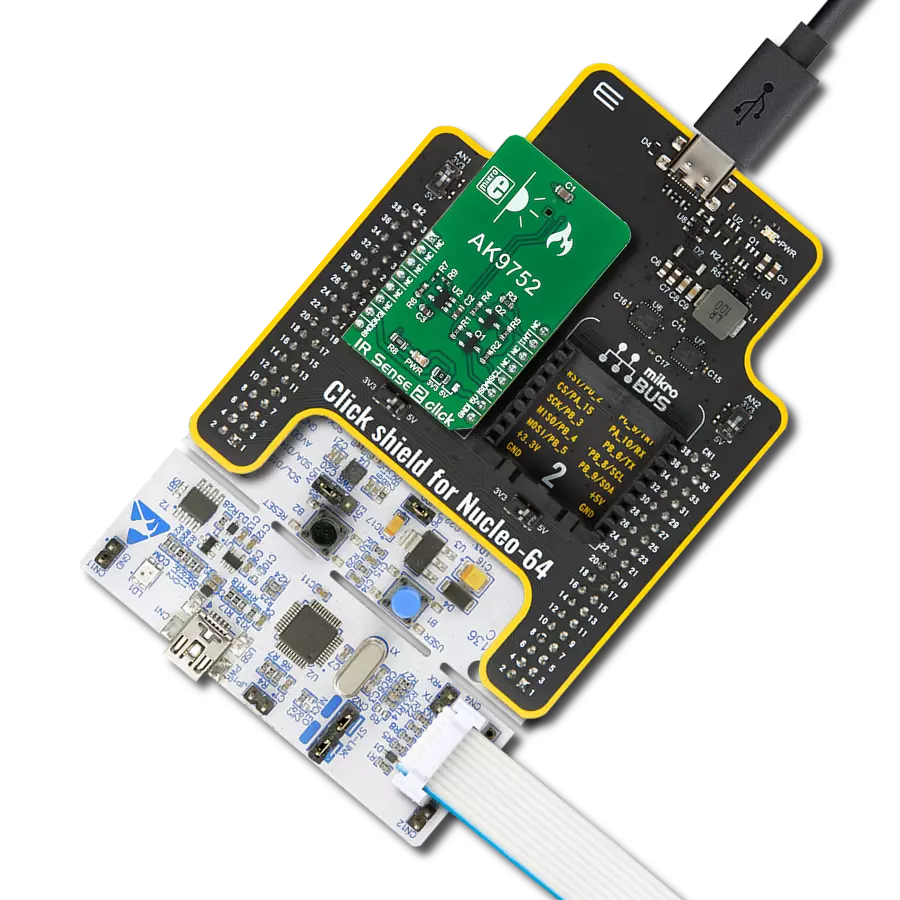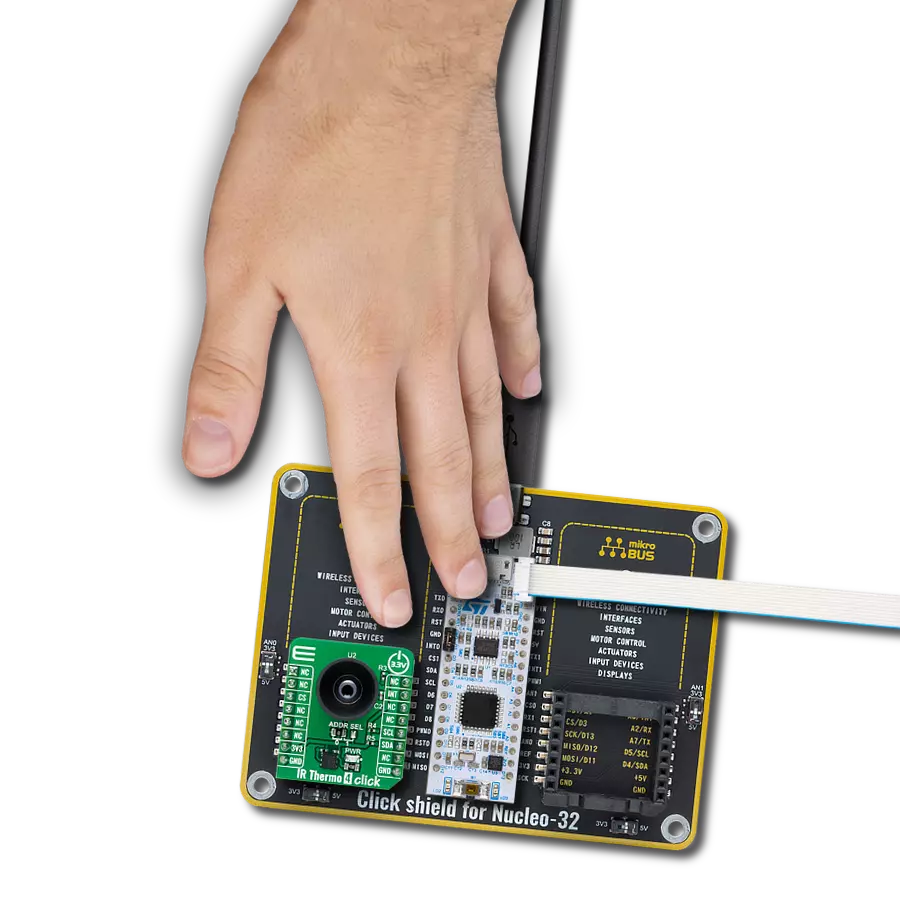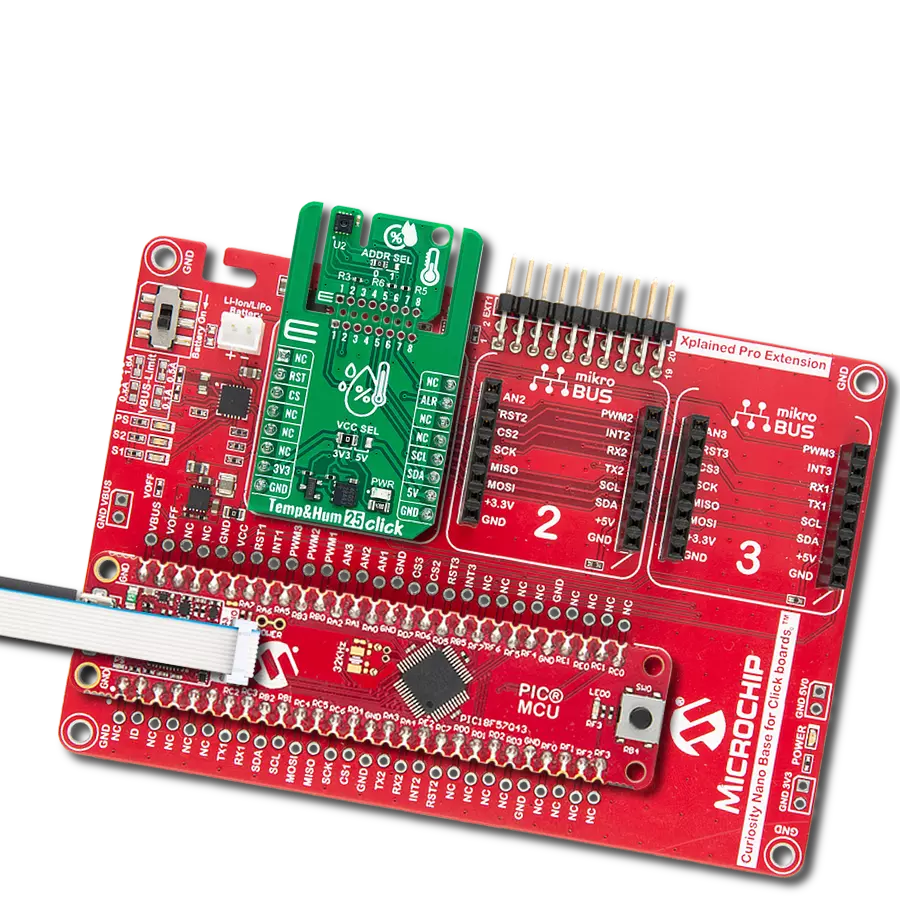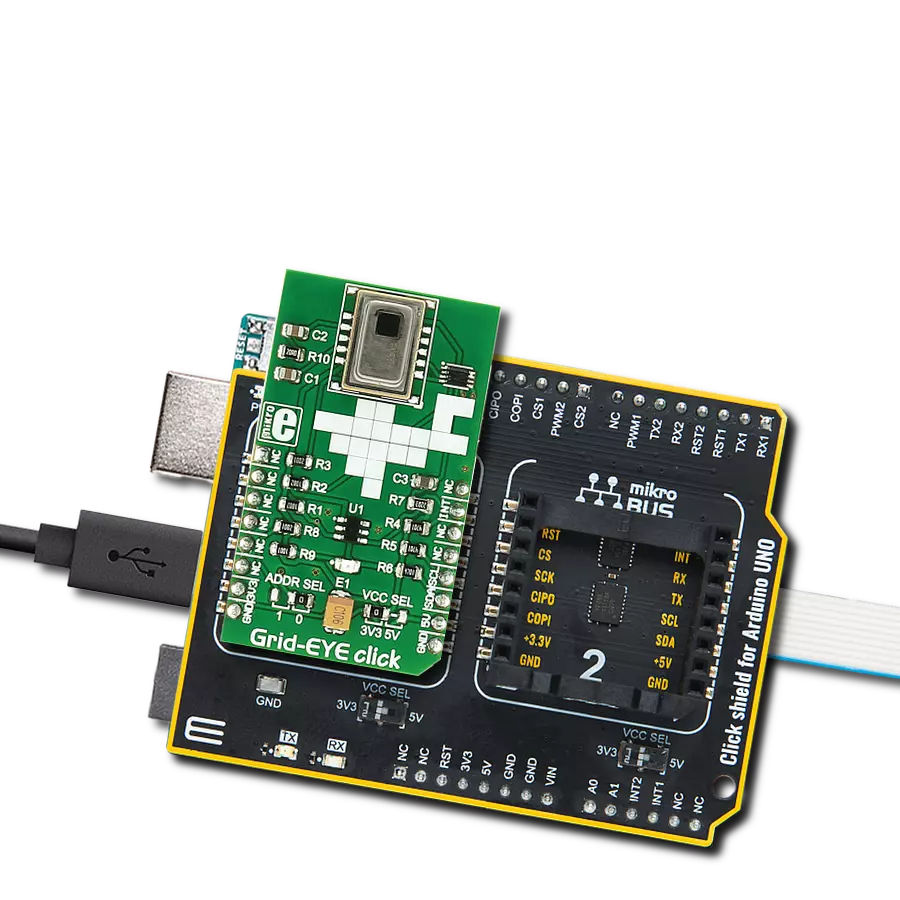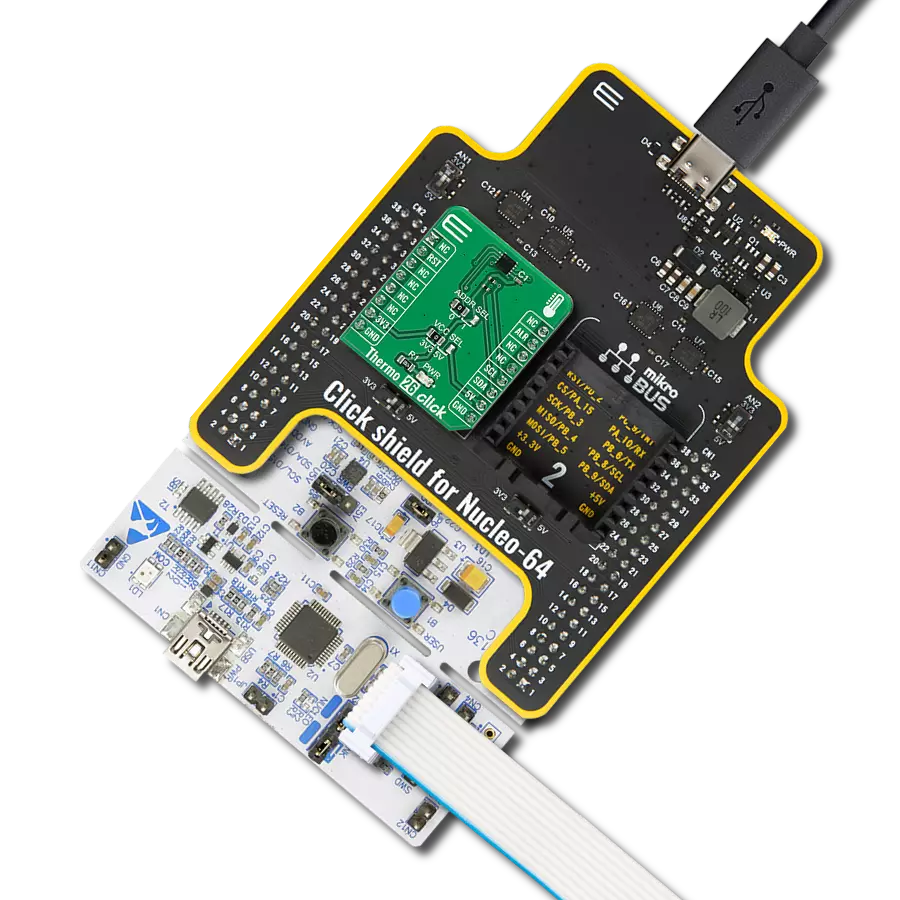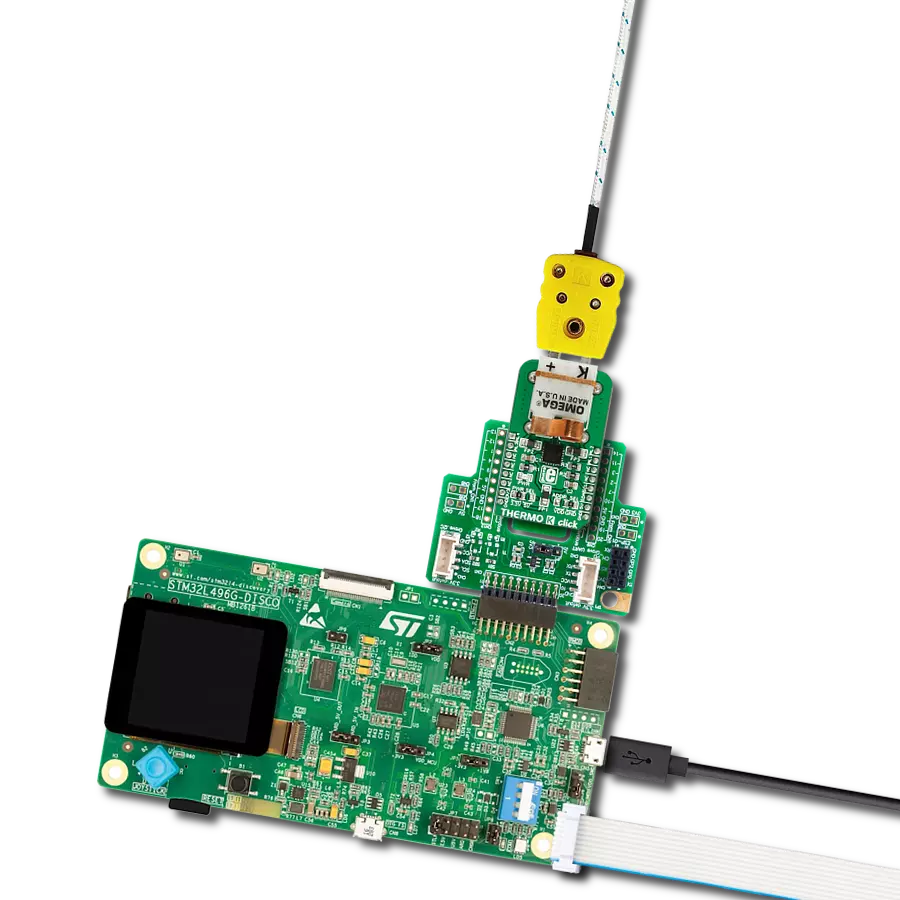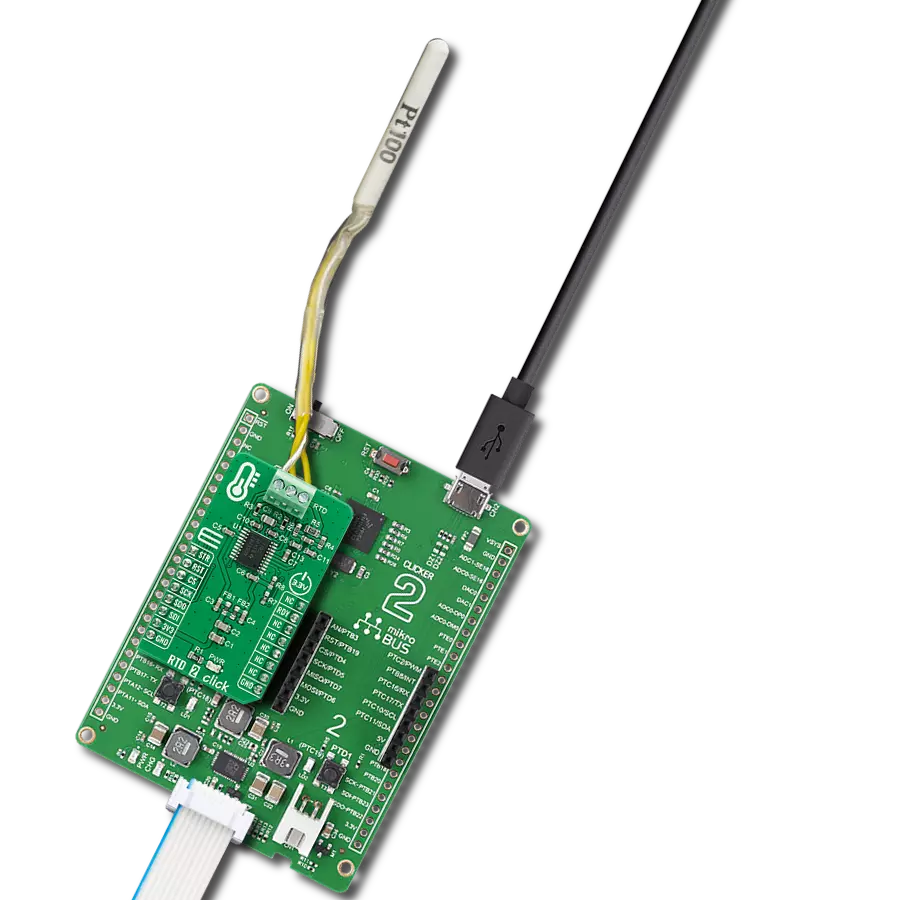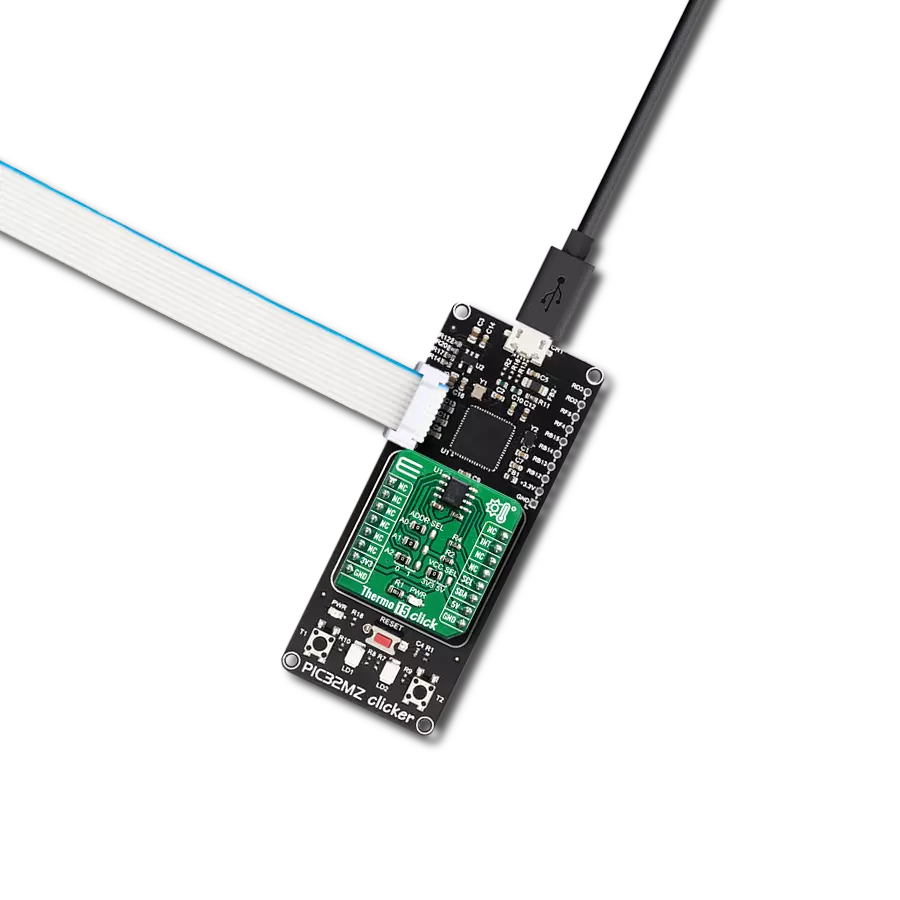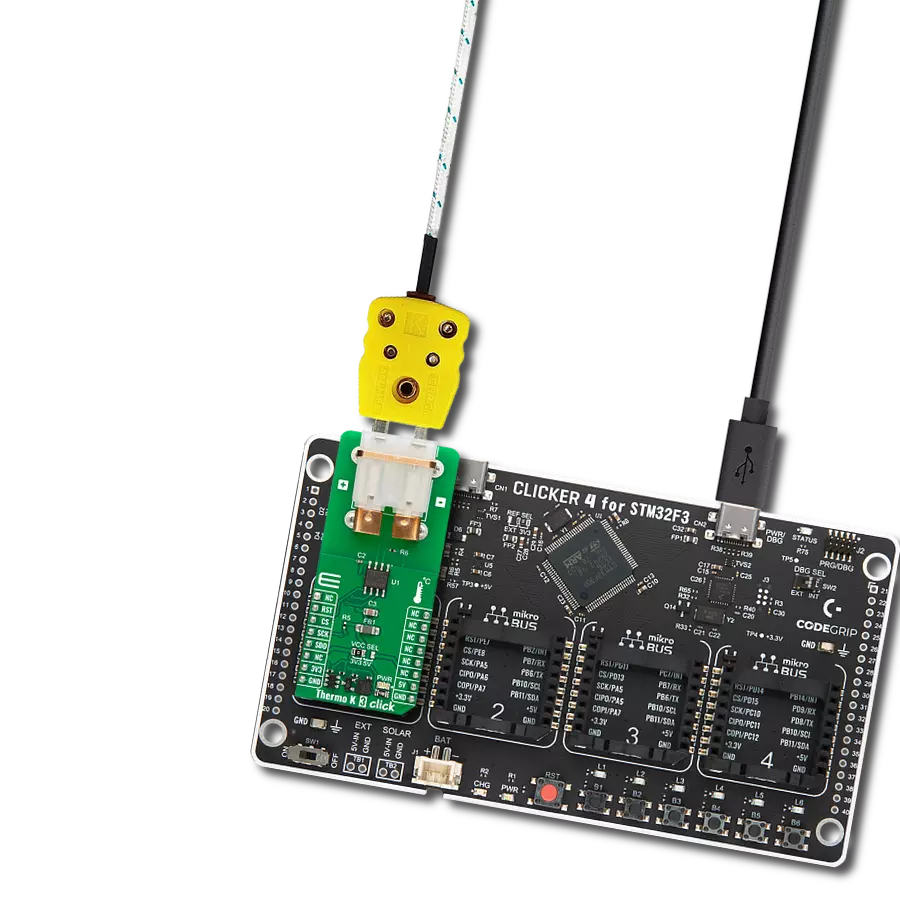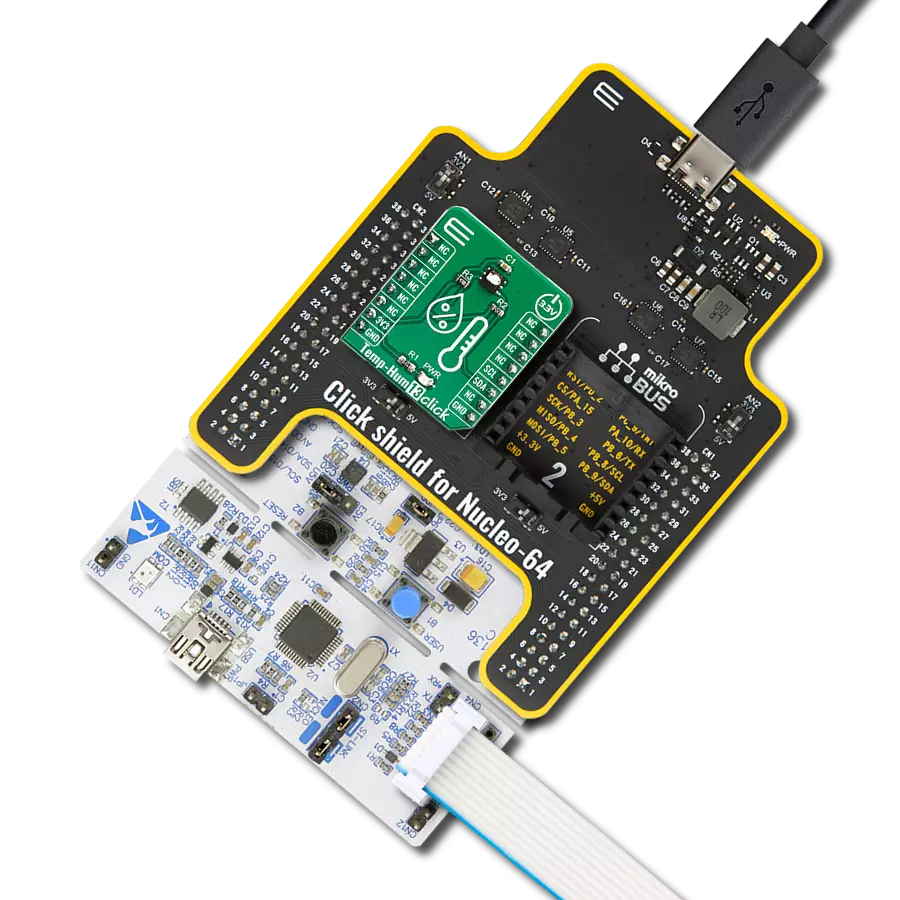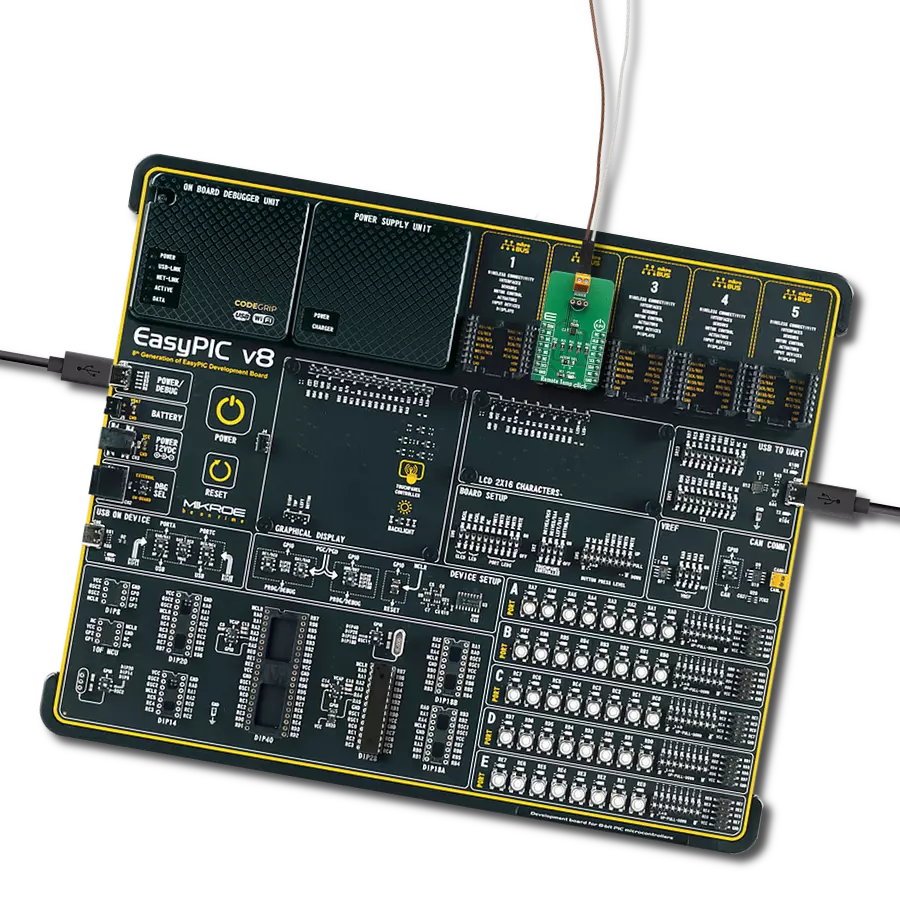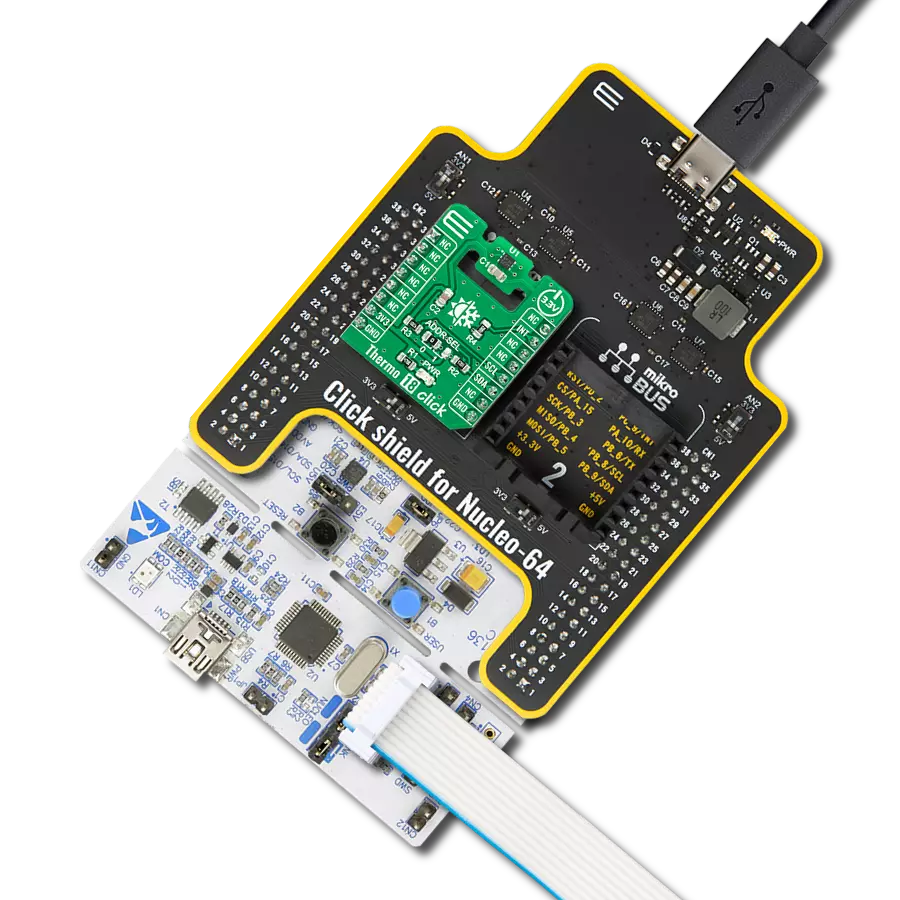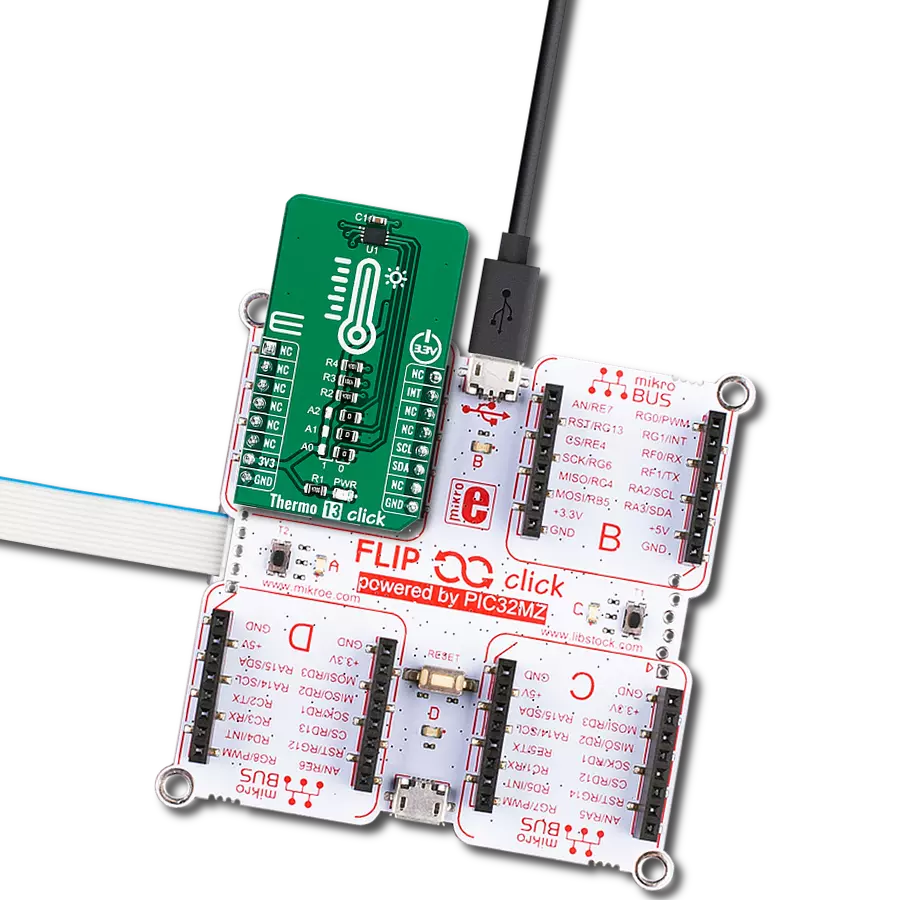在环境条件直接影响功能、产品质量或用户舒适度的应用中,这是一种非常宝贵的解决方案。
A
A
硬件概览
它是如何工作的?
SHT1x Click基于Sensirion的湿度和温度传感器SHT11。SHT11是一种强大而可靠的传感器,即使在超出正常范围的条件下,一旦条件稳定,它也可以重新校准自身。该传感器在推荐的正常温度范围内(-20°C至100°C)运行时性能最佳。长期暴露于正常范围之外的条件可能会暂时偏移RH信号。在返回正常温度范围后,传感器将自行缓慢恢复到校准状态。此外,请注意,长时间暴露于极端条件可能会加速老 化。尽管典型的相对湿度分辨率为12位,温度读数为
14位,但SHT11上的两个传感器都无缝地耦合到14位ADC。相对湿度传感器使用独特的电容式传感器元件,而带隙传感器测量温度。SHT11在精密湿度室中单独校准,并且校准系数存储在板载OTP存储器中。SHT1x Click通过mikroBUS™插座上的I2C接口与主机MCU通信,通信速度高达1MHz。SHT1x Click没有复位引脚;如果与传感器的通信中断,可以通过信号 序列重新设置传感器。虽然SHT1x Click不能直接测量露点,但可以使用湿度和温度读数计算露点。这是可
能的,因为同一块单片芯片测量湿度和温度。但是,重要的是要注意,传感器对光不敏感,长时间暴露于强烈的紫外辐射可能会导致外壳随时间的推移而劣化。此Click板可以通过PWR SEL跳线选择3.3V或5V逻辑电压级别进行操作。这样,既支持3.3V又支持5V的MCU可以正确使用通信线路。此外,此Click板配备了一个包含易于使用的函数和示例代码的库,可用作进一步开发的参考。
功能概述
开发板
Nucleo-64 搭载 STM32F410RB MCU 提供了一种经济高效且灵活的平台,供开发者探索新想法并原型设计他们的项目。该板利用 STM32 微控制器的多功能性,使用户能够为他们的项目选择最佳的性能与功耗平衡。它配备了 LQFP64 封装的 STM32 微控制器,并包含了如用户 LED(同时作为 ARDUINO® 信号)、用户和复位按钮,以及 32.768kHz 晶体振荡器用于精确的计时操作等基本组件。Nucleo-64 板设计考虑到扩展性和灵活性,它特有的 ARDUINO® Uno
V3 扩展连接器和 ST morpho 扩展引脚头,提供了对 STM32 I/O 的完全访问,以实现全面的项目整合。电源供应选项灵活,支持 ST-LINK USB VBUS 或外部电源,确保在各种开发环境中的适应性。该板还配备了一个具有 USB 重枚举功能的板载 ST-LINK 调试器/编程器,简化了编程和调试过程。此外,该板设计旨在简化高级开发,它的外部 SMPS 为 Vcore 逻辑供电提供高效支持,支持 USB 设备全速或 USB SNK/UFP 全速,并内置加密功能,提升了项目的功效
和安全性。通过外部 SMPS 实验的专用连接器、 用于 ST-LINK 的 USB 连接器以及 MIPI® 调试连接器,提供了更多的硬件接口和实验可能性。开发者将通过 STM32Cube MCU Package 提供的全面免费软件库和示例得到广泛支持。这些,加上与多种集成开发环境(IDE)的兼容性,包括 IAR Embedded Workbench®、MDK-ARM 和 STM32CubeIDE,确保了流畅且高效的开发体验,使用户能够充分利用 Nucleo-64 板在他们的项目中的能力。
微控制器概述
MCU卡片 / MCU
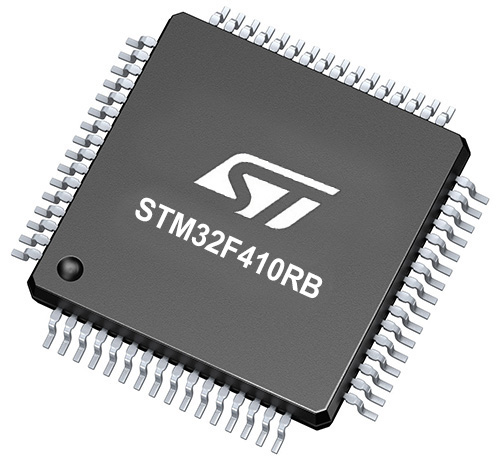
建筑
ARM Cortex-M4
MCU 内存 (KB)
128
硅供应商
STMicroelectronics
引脚数
64
RAM (字节)
32768
你完善了我!
配件
Click Shield for Nucleo-64 配备了两个专有的 mikroBUS™ 插座,使得所有的 Click board™ 设备都可以轻松地与 STM32 Nucleo-64 开发板连接。这样,Mikroe 允许其用户从不断增长的 Click boards™ 范围中添加任何功能,如 WiFi、GSM、GPS、蓝牙、ZigBee、环境传感器、LED、语音识别、电机控制、运动传感器等。您可以使用超过 1537 个 Click boards™,这些 Click boards™ 可以堆叠和集成。STM32 Nucleo-64 开发板基于 64 引脚封装的微控制器,采用 32 位 MCU,配备 ARM Cortex M4 处理器,运行速度为 84MHz,具有 512Kb Flash 和 96KB SRAM,分为两个区域,顶部区域代表 ST-Link/V2 调试器和编程器,而底部区域是一个实际的开发板。通过 USB 连接方便地控制和供电这些板子,以便直接对 Nucleo-64 开发板进行编程和高效调试,其中还需要额外的 USB 线连接到板子上的 USB 迷你接口。大多数 STM32 微控制器引脚都连接到了板子左右边缘的 IO 引脚上,然后连接到两个现有的 mikroBUS™ 插座上。该 Click Shield 还有几个开关,用于选择 mikroBUS™ 插座上模拟信号的逻辑电平和 mikroBUS™ 插座本身的逻辑电压电平。此外,用户还可以通过现有的双向电平转换器,使用任何 Click board™,无论 Click board™ 是否在 3.3V 或 5V 逻辑电压电平下运行。一旦将 STM32 Nucleo-64 开发板与我们的 Click Shield for Nucleo-64 连接,您就可以访问数百个工作于 3.3V 或 5V 逻辑电压电平的 Click boards™。
使用的MCU引脚
mikroBUS™映射器
“仔细看看!”
Click board™ 原理图

一步一步来
项目组装
软件支持
库描述
这个库包含 SHT1x Click 驱动程序的 API。
关键函数:
sht1x_output_sda- 设置引脚为输出模式。sht1x_input_sda- 设置引脚为输入模式。sht1x_sda_high- 设置 SDA 高电平的功能。
开源
代码示例
完整的应用程序代码和一个现成的项目可以通过NECTO Studio包管理器直接安装到NECTO Studio。 应用程序代码也可以在MIKROE的GitHub账户中找到。
/*!
* \file
* \brief SHT1x Click example
*
* # Description
* This Click measures temperature and humidity.
*
* The demo application is composed of two sections :
*
* ## Application Init
* Initialization driver enables GPIO.
*
* ## Application Task
* This example demonstrates the use of SHT1x Click board by measuring
temperature and humidity, and displays the results on USART terminal.
*
*
* \author MikroE Team
*
*/
// ------------------------------------------------------------------- INCLUDES
#include "board.h"
#include "log.h"
#include "sht1x.h"
// ------------------------------------------------------------------ VARIABLES
static sht1x_t sht1x;
static log_t logger;
static sht1x_cfg_t cfg;
static uint8_t i;
static uint8_t data_val;
static uint8_t err;
static uint8_t msb;
static uint8_t lsb;
static uint8_t checksum;
static uint16_t t;
static uint16_t h;
static float value;
static uint8_t uc_sens_err;
static int16_t int_temp;
static int16_t int_humi;
static float humidity;
static float temperature;
// ------------------------------------------------------ APPLICATION FUNCTIONS
void sht1x_trans_start ( )
{
sht1x_output_sda ( &sht1x, &cfg );
sht1x_sda_high( &sht1x );
sht1x_input_sda ( &sht1x, &cfg );
sht1x_scl_low( &sht1x );
Delay_us( 1 );
sht1x_scl_high( &sht1x );
Delay_us( 1 );
sht1x_output_sda ( &sht1x, &cfg );
sht1x_sda_low( &sht1x );
Delay_us( 1 );
sht1x_scl_low( &sht1x );
Delay_us( 3 );
sht1x_scl_high( &sht1x );
Delay_us( 1 );
sht1x_input_sda ( &sht1x, &cfg );
Delay_us( 1 );
sht1x_scl_low( &sht1x );
}
uint8_t sht1x_read_byte( uint8_t ack )
{
i = 0x80;
data_val = 0;
sht1x_output_sda ( &sht1x, &cfg );
sht1x_sda_high( &sht1x );
sht1x_input_sda ( &sht1x, &cfg );
sht1x_scl_low( &sht1x );
while( i )
{
sht1x_scl_high( &sht1x );
Delay_us( 1 );
if ( sht1x_get_sda( &sht1x ) == 1 )
{
data_val = ( data_val | i );
}
sht1x_scl_low( &sht1x );
Delay_us( 1 );
i = ( i >> 1 );
}
sht1x_output_sda ( &sht1x, &cfg );
if( ack )
{
sht1x_sda_low( &sht1x );
}
else
{
sht1x_sda_high( &sht1x );
}
sht1x_scl_high( &sht1x );
Delay_us( 3 );
sht1x_scl_low( &sht1x );
Delay_us( 1 );
sht1x_sda_high( &sht1x );
sht1x_input_sda ( &sht1x, &cfg );
return data_val;
}
uint8_t sht1x_write_byte( uint8_t value )
{
i = 0x80;
err = 0;
sht1x_output_sda ( &sht1x, &cfg );
while( i )
{
if ( i & value )
{
sht1x_sda_high( &sht1x );
}
else
{
sht1x_sda_low( &sht1x );
}
sht1x_scl_high( &sht1x );
Delay_us( 3 );
sht1x_scl_low( &sht1x );
Delay_us( 3 );
i = ( i >> 1 );
}
sht1x_sda_high( &sht1x );
sht1x_input_sda ( &sht1x, &cfg );
sht1x_scl_high( &sht1x );
Delay_us( 3 );
if ( sht1x_get_sda( &sht1x ) == 1 )
{
err = 1;
}
Delay_us( 1 );
sht1x_scl_low( &sht1x );
return err;
}
uint8_t sht1x_measure( uint16_t *p_val, uint8_t mode )
{
i = 0;
*p_val = 0;
sht1x_trans_start( );
if( mode )
{
mode = SHT1X_MEAS_HUMI;
}
else
{
mode = SHT1X_MEAS_TEMP;
}
if( sht1x_write_byte( mode ) )
{
return( 1 );
}
sht1x_input_sda ( &sht1x, &cfg );
while( i < 240 )
{
Delay_ms ( 3 );
if ( sht1x_get_sda( &sht1x ) == 0 )
{
i = 0;
break;
}
i++;
}
if( i )
{
return( 2 );
}
msb = sht1x_read_byte( SHT1X_ACK );
lsb = sht1x_read_byte( SHT1X_ACK );
checksum = sht1x_read_byte( SHT1X_NACK );
*p_val = ( msb << 8 ) | lsb ;
return( 0 );
}
void sht1x_read_results ( float *f_t, float *f_rh )
{
uc_sens_err = 0;
uc_sens_err = sht1x_measure( &t, 0 );
int_temp = ( int16_t )( sht1x_calc_temp( &sht1x, t ) * 10 );
uc_sens_err = sht1x_measure(&h, 1);
int_humi = ( int16_t )( sht1x_calc_humi( &sht1x, h, t ) * 10 );
value = ( float )int_temp;
*f_t = value / 10;
value = ( float )int_humi;
*f_rh = value / 10;
}
uint8_t sht1x_rd_stat_reg ( uint8_t *p_val )
{
checksum = 0;
sht1x_trans_start( );
if( sht1x_write_byte( SHT1X_STAT_REG_R ) )
{
return 1;
}
*p_val = sht1x_read_byte( SHT1X_ACK );
checksum = sht1x_read_byte( SHT1X_NACK );
return 0;
}
uint8_t sht1x_wr_stat_reg ( uint8_t value )
{
sht1x_trans_start();
if( sht1x_write_byte( SHT1X_STAT_REG_W ) )
{
return 1;
}
if( sht1x_write_byte( value ) )
{
return 1;
}
return 0;
}
void sht1x_connection_reset ( )
{
sht1x_output_sda ( &sht1x, &cfg );
sht1x_sda_high( &sht1x );
sht1x_input_sda ( &sht1x, &cfg );
sht1x_scl_low( &sht1x );
for( i = 0; i < 9; i++ )
{
sht1x_scl_high( &sht1x );
Delay_us( 3 );
sht1x_scl_low( &sht1x );
Delay_us( 3 );
}
sht1x_trans_start( );
}
uint8_t sht1x_soft_reset ( )
{
sht1x_connection_reset( );
return ( sht1x_write_byte( SHT1X_SOFT_RESET ) );
}
void application_init ( void )
{
log_cfg_t log_cfg;
/**
* Logger initialization.
* Default baud rate: 115200
* Default log level: LOG_LEVEL_DEBUG
* @note If USB_UART_RX and USB_UART_TX
* are defined as HAL_PIN_NC, you will
* need to define them manually for log to work.
* See @b LOG_MAP_USB_UART macro definition for detailed explanation.
*/
LOG_MAP_USB_UART( log_cfg );
log_init( &logger, &log_cfg );
log_info(&logger, "---- Application Init ----");
// Click initialization.
sht1x_cfg_setup( &cfg );
SHT1X_MAP_MIKROBUS( cfg, MIKROBUS_1 );
sht1x_init( &sht1x, &cfg );
}
void application_task ( void )
{
sht1x_read_results( &temperature, &humidity );
log_printf( &logger, " Temperature: %.2f ", temperature );
log_printf( &logger, " C \r\n" );
log_printf( &logger, " Humidity: %.2f ", humidity );
log_printf( &logger, " \r\n" );
Delay_ms ( 1000 );
}
int main ( void )
{
/* Do not remove this line or clock might not be set correctly. */
#ifdef PREINIT_SUPPORTED
preinit();
#endif
application_init( );
for ( ; ; )
{
application_task( );
}
return 0;
}
// ------------------------------------------------------------------------ END
额外支持
资源
类别:温度与湿度
